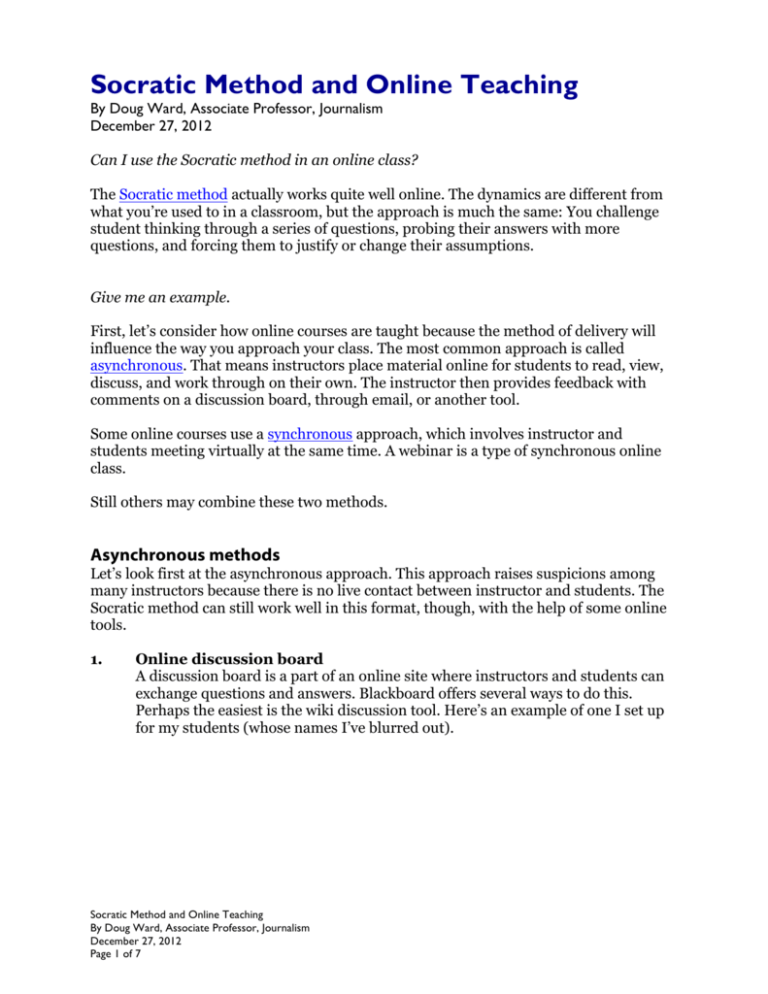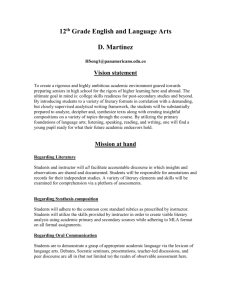Socratic Method and Online Teaching
advertisement

Socratic Method and Online Teaching By Doug Ward, Associate Professor, Journalism December 27, 2012 Can I use the Socratic method in an online class? The Socratic method actually works quite well online. The dynamics are different from what you’re used to in a classroom, but the approach is much the same: You challenge student thinking through a series of questions, probing their answers with more questions, and forcing them to justify or change their assumptions. Give me an example. First, let’s consider how online courses are taught because the method of delivery will influence the way you approach your class. The most common approach is called asynchronous. That means instructors place material online for students to read, view, discuss, and work through on their own. The instructor then provides feedback with comments on a discussion board, through email, or another tool. Some online courses use a synchronous approach, which involves instructor and students meeting virtually at the same time. A webinar is a type of synchronous online class. Still others may combine these two methods. Asynchronous methods Let’s look first at the asynchronous approach. This approach raises suspicions among many instructors because there is no live contact between instructor and students. The Socratic method can still work well in this format, though, with the help of some online tools. 1. Online discussion board A discussion board is a part of an online site where instructors and students can exchange questions and answers. Blackboard offers several ways to do this. Perhaps the easiest is the wiki discussion tool. Here’s an example of one I set up for my students (whose names I’ve blurred out). Socratic Method and Online Teaching By Doug Ward, Associate Professor, Journalism December 27, 2012 Page 1 of 7 This type of forum works much like a classroom discussion, but over an extended period of time. An instructor poses a question or questions and students respond. The instructor can respond to student answers and students can respond to those posted by their classmates. To use this approach, the instructor must lay down clear ground rules. For instance, when will the discussion end? How many times will students be expected to post or to respond classmates’ answers? Generating a solid discussion usually requires two deadlines: one for the students’ initial posts and another for their responses to others’ work. 2. Small group discussions You could also use a group approach to online discussions. In this approach, students work in small groups online and discuss a question among themselves, with the faculty member weighing in occasionally. I used this approach in my online class, dividing 24 students into three discussion groups of eight. I designated discussion leaders each week and had those discussion leaders designate a topic and readings. That worked well except for one thing: The volume of comments overwhelmed me, and I found it impossible to keep up with all the discussion threads in each group. (I wrote about my experiences in The Chronicle of Higher Education.) Socratic Method and Online Teaching By Doug Ward, Associate Professor, Journalism December 27, 2012 Page 2 of 7 Dan Bernstein, director of the Center for Teaching Excellence, and Diana Marrs, the associate director for instructional development at the Edwards Campus, offered a solution to that problem: Have each group reach a consensus on questions and then bring those responses to the entire group. Then the instructor can lead a discussion about those responses. I’ll definitely try that approach next time I teach a similar online class. 3. Online discussion board with video You could use a similar approach with an online tool called VoiceThread. With VoiceThread, the instructor posts questions, video, photos or other material online and asks students to submit video responses. They do this with a webcam. The class material appears in the center of the screen, and the student responses line the sides. Here’s an example of a VoiceThread discussion page (again with student identities blurred) from an online class I taught. In this case, I introduced myself to the class and asked the students to do the same. I’ve found that VoiceThread is most effective with video responses, but it offers other options. Students can comment with text or with voice alone (via a phone call). Each video or audio response is limited to three minutes, but students and instructor can post several times in response to others’ comments, mimicking a class discussion. Socratic Method and Online Teaching By Doug Ward, Associate Professor, Journalism December 27, 2012 Page 3 of 7 One of the benefits of VoiceThread is that it forces students to articulate their answers orally. The three-minute time limit forces them to zero in on the elements they want to emphasize, and the video element pushes most students to better prepare their answers because they don’t want to look foolish in the recording. The video element also frightens some students – and instructors – initially, though that fear eases with practice. Another benefit of both VoiceThread and a discussion board is that each student has an opportunity to respond to a question, something that is usually impossible in a physical classroom. That allows instructors to expand the Socratic method to all students, not just a few who speak up. Of course, that benefit also has a downside: grading time. If each student in a class of 25 posts a three-minute video, that means the instructor will have 75 minutes of comments to work through. If students post more than one response, the time grows. Synchronous methods If you prefer to meet with students live, you can do that fairly easily with a tool called Adobe Connect. With this tool, you set up a virtual meeting room and send out email invitations asking students to join a session at a specific time. You can conduct a live session with video from you and students, or you can create a virtual chat in which you communicate only by text. 1. Virtual office hours (no video) One way to use Adobe Connect is to set up virtual office hours. That works essentially the same way physical office hours do, except students must connect virtually to a room you set up. Here’s an example of an Adobe Connect session in which I did that. Socratic Method and Online Teaching By Doug Ward, Associate Professor, Journalism December 27, 2012 Page 4 of 7 Once students join a session, their names show up under an Attendees panel on the right. They can then type questions, which show up in a separate panel, as do the instructor’s responses. Everyone logged in can see the responses from other participants. This type of session requires no webcam or microphone. Instructor and students need only a computer with Internet access. Some students may feel more comfortable in this type of session than they would in a live video session. It’s essentially a variation of texting or instant messaging, and most students take to it effortlessly. I also found that these sessions helped me get to know students better. They also cut down on email questions. 2. Live video sessions A video session requires a bit more work, but it also provides more options. You will need a webcam and perhaps a headset for an Adobe Connect video session – IT offers some suggestions – as will anyone who wants to speak via video. Once you are logged in, your image will appear in a box on the screen. If you choose to do so, others’ images will appear, as well. You can speak as you would in a classroom, using your computer screen to show PowerPoint slides, videos, text, photos or anything else you want the class to see. Students can type in comments or raise their hands virtually by pressing a button. If you wish, you can turn the main screen over to participants one at a time, allowing them to respond or present information in the same way you do. You can also record a session and allow students who missed the virtual class to view a recording later. Socratic Method and Online Teaching By Doug Ward, Associate Professor, Journalism December 27, 2012 Page 5 of 7 Are there problems with this approach? I did only a couple of live sessions in my recent online class, mostly because students said they didn’t want them. They didn’t like the idea of being tied down to specific times, preferring to work through material on their own schedules. My class was made up of professional graduate students who had full-time jobs, though. Undergraduates may respond differently. Marrs again offered an excellent suggestion: Require students to check in at least occasionally during virtual office hours. That nudge helps student and instructor connect with each other. Final thoughts Those are just some common (and fairly easy) ways to use the Socratic method online. The virtual world offers many types of learning tools. As in the classroom, you have to find the ones that work best for you. I’m still not convinced. If you still don’t think the Socratic method will work online, I would suggest using it to examine your assumptions: Why don’t you think it will work? Have you tried? What is holding you back? After you’ve answered those, consider one more: What would Socrates do? Really. Socratic Method and Online Teaching By Doug Ward, Associate Professor, Journalism December 27, 2012 Page 6 of 7 Sources and resources Blackboard Knowledge Base. https://kuit.servicenow.com/kb_home.do?jvar_view_topic=Blackboard%3A+Instructors&sysparm_refer= kb_home.do British Council, Teaching Knowledge Database. http://www.teachingenglish.org.uk/knowledge-database Hrastinaki, Stefan. “Asynchronous and Synchronous E-Learning,” Educause Quarterly 31 (October-December 2008). http://www.educause.edu/ero/article/asynchronousand-synchronous-e-learning (accessed 23 September 2012). “Presenting with desktop connect,” KU Information Technology. http://technology.ku.edu/desktopconnect/presenting Stanford University Center for Teaching and Learning, “The Socratic Method: What It is and How to Use it in the Classroom,” Speaking of Teaching 13 (Fall 2003). “Synchronous vs. Asynchronous Classes,” eLearners.com, 2 April 2012. http://www.elearners.com/online-education-resources/online-learning/synchronousvs-asynchronous-classes/ (accessed 23 September 2012). Socratic Method and Online Teaching By Doug Ward, Associate Professor, Journalism December 27, 2012 Page 7 of 7





